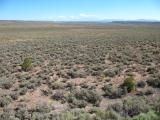 © Mike Norton (Colorado)
© Mike Norton (Colorado)

Sagebrush
Overview
The major types of sagebrush ecological systems in Colorado are big sagebrush shrublands and montane sagebrush steppe. These systems occur throughout the much of western U.S. Although they can be found on the east slope of Colorado, the largest occurrences are on the western slope. North Park, Middle Park, and the upper Gunnison Basin have large and continuous stands of sagebrush shrublands. Sagebrush shrublands are characterized by a dense stands of taller sagebrush species with a significant herbaceous understory. These taller shrubs distinguish the sagebrush shrubland ecological system from sagebrush steppe ecological system, which is dominated by dwarf sagebrush species. Big sagebrush shrublands are typically found in broad basins between mountain ranges, on plains and foothills. Sagebrush steppe primarily occurs on ridges, near flat ridgetops, and mountain slopes. Sagebrush systesm are usually found at elevations from 7,000 to 10,000 feet.
There are 21 species of sagebrush are found in Colorado, and many of them are difficult to distinguish from one another. They all have gray-green leaves with a strong sage fragrance and small wind-pollinated flowers. Some of our sagebrush species (such as black sage) are very short, seldom taller than mid-shin height, while others (such as big sagebrush) can reach heights up to six feet.
Sagebrush ecological systems are not adapted to frequent fires. In pre-settlement times, stand-replacing fires occurred roughly every 40-60 years, with smaller fires every 20-25 years. Taller sagebrush shrublands are more susceptible to natural fire than dwarf sagebrush steppe. Repeated burning every few years or burning in summer will deplete native perennial grasses in the understory and allow invasive forbs and cheatgrass to increase. Following a fire, sagebrush must reestablish itself from seed; growth is slow and recovery is slow. Fire favors shrubs like rabbitbrush that can re-sprout after fire.
Rarity in Sagebrush systems
The most significant at-risk animal species in Colorado’s sagebrush ecosystem is the Gunnison Sage Grouse. This species is ranked “critically imperiled” (G1S1) by the Colorado Natural Heritage Program, and is listed as a Tier 1 Species of Greatest Conservation need by the Colorado Division of Wildlife. Other Tier 1 Species of Greatest Conservation Need that are found exclusively (or almost exclusively) in sagebrush habitats are Greater Sage Grouse, Brewer’s Sparrow and Sage Sparrow. In addition, several of Colorado’s rarest plants are found primarily in sagebrush habitats. These include the federally listed (Endangered) Osterhout’s milkvetch, as well as several other globally rare members of the milkvetch family (Gunnison milkvetch, violet milkvetch, and skiff milkvetch). Other rare Colorado plants that are most commonly found in sagebrush habitats are the globally rare narrow-leaf evening primrose, Bessey locoweed, Fremont’s beardtongue, and Harrington’s beardtongue.
Conservation
Healthy sagebrush shrublands are very productive, and are often grazed by domestic livestock. Prolonged livestock use can cause a decrease in the abundance of native grasses in the understory, and an increase in the cover of shrubs and non-native grasses such as Kentucky bluegrass. Trampling from livestock grazing significantly decreases the number of sagebrush and grass seedlings that are able to grow. The condition of most sagebrush steppe has been degraded due to fire suppression and heavy livestock grazing over the last century. The past history of heavy livestock grazing (especially in the early to mid 1900s) has altered the composition of plant species in the understory, and some sagebrush areas were chained to remove sagebrush in favor of grasslands to improve forage for cattle. Although many livestock operations are now more sensitive in their treatment of sagebrush habitats than they once were, recovery in these systems is slow. In addition to altered species composition Colorado’s high-paced energy development is fragmenting many of our remaining sagebrush patches. It is unclear how long it will take to restore the health of degraded occurrences. According to Colorado’s Biodiversity Scorecard, the sagebrush ecological system is weakly conserved in Colorado, with a high threats score and a low protection score. Sagebrush is identified as a high priority habitat in Colorado's Wildlife Action Plan.
Related Resources
Colorado Natural Heritage Program ecological system description for Sagebrush shrublands
Colorado Natural Heritage Program ecological system description for sagebrush steppe
NatureServe Explorer Online Encyclopedia
Colorado Division of Wildlife's Sagebrush and Sage Species Conservation Strategy
Colorado Greater Sage-grouse Conservation Plan





